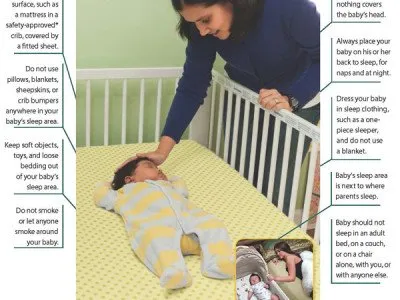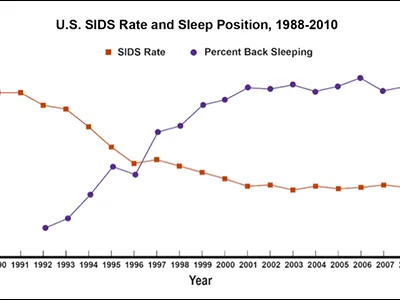
The three leading causes of infant mortality (congenital malformations, disorders related to short gestation and low birth weight, and sudden infant death syndrome [SIDS]) accounted for approximately 43% of all infant deaths in the United States (1). Neural tube defects (NTD) can be prevented by starting folic acid 3-12 months before a planned pregnancy or daily folic acid for all reproductive age women to avoid the complications caused by the 50% unplanned pregnancy rate in the US (see my previous blog on NTD @dnagrimes). A future blog will discuss how to prevent birth defects from maternal diabetes.
Sudden Infant Death Syndrome (SIDS) is the sudden, unexplained death of a baby younger than 1 year of age that doesn’t have a known cause even after a complete investigation. This investigation includes performing a complete autopsy, examining the death scene, and reviewing the clinical history. Most SIDS deaths occur between 1 and 4 months of age. Ninety percent (90%) of SIDS occur before 6 months of age. What are the known factors that can prevent some of these SIDS deaths?
Prone or “tummy” sleeping used to be the recommended position for infant sleeping. Following several studies showing this to be dangerous for infants less than one year old, the American Academy of Pediatrics (AAP) in 1992 began recommending that all infants less than a year old always be put to sleep on their backs, on a firm mattress, with a fitted sheet, in a separate and safe crib/bed in their parent’s bedroom, with a blanket or sleeper, not covering the babies head, and no bumper pads or toys. See the picture from Safe to Sleep (2). Since these recommendations went into effect we have seen a steady decrease in tummy sleeping and a decrease in SIDS (3). It is especially important that parents make sure that baby sitters, day care centers, and grandparents follow these recommendations. Many grandmothers will say that they “put their previous twenty grandchildren to sleep on their tummies with no problems”, they were lucky, not safe. Share this slide with them (3).

The highest risk of SIDS to your baby is putting your baby on their tummy on a soft surface (head sinks more than an inch into the mattress or blanket) for sleeping. This combination multiples the risk of SIDS by a factor of 21 times your baby being on their back on a firm mattress. Your baby using a pacifier decreases SIDS by 70% when compared to no pacifier. Breast feeding also decreases the risk of SIDS. Smoking during and after pregnancy increases the risk of SIDS.
Some immunizations are given during the peak time for SIDS. This raised the question of whether these immunizations should be delayed until after the high-risk months for SIDS (1-6 months after birth). Studies confirmed that immunizations did not increase the risk of SIDS but lowered the risk (4) when given at their usual time.Breastfeeding and use of a pacifier also decrease SIDS. For more information please see the “Thirteen ways to keep your baby from dying from SIDS”(5) on the “Safe to Sleep” website.
References
1. www.cdc.gov/reproductivehealth/maternalinfanthealth/infantmortality.htm
2. www1.nichd.nih.gov/sts/about/environment/Pages/look.aspx
3. www1.nichd.nih.gov/sts/about/SIDS/Pages/progress.aspx
4. www.cdc.gov/vaccinesafety/concerns/sids
5. www1.nichd.nih.gov/sts/about/risk/Pages/reduce.aspx